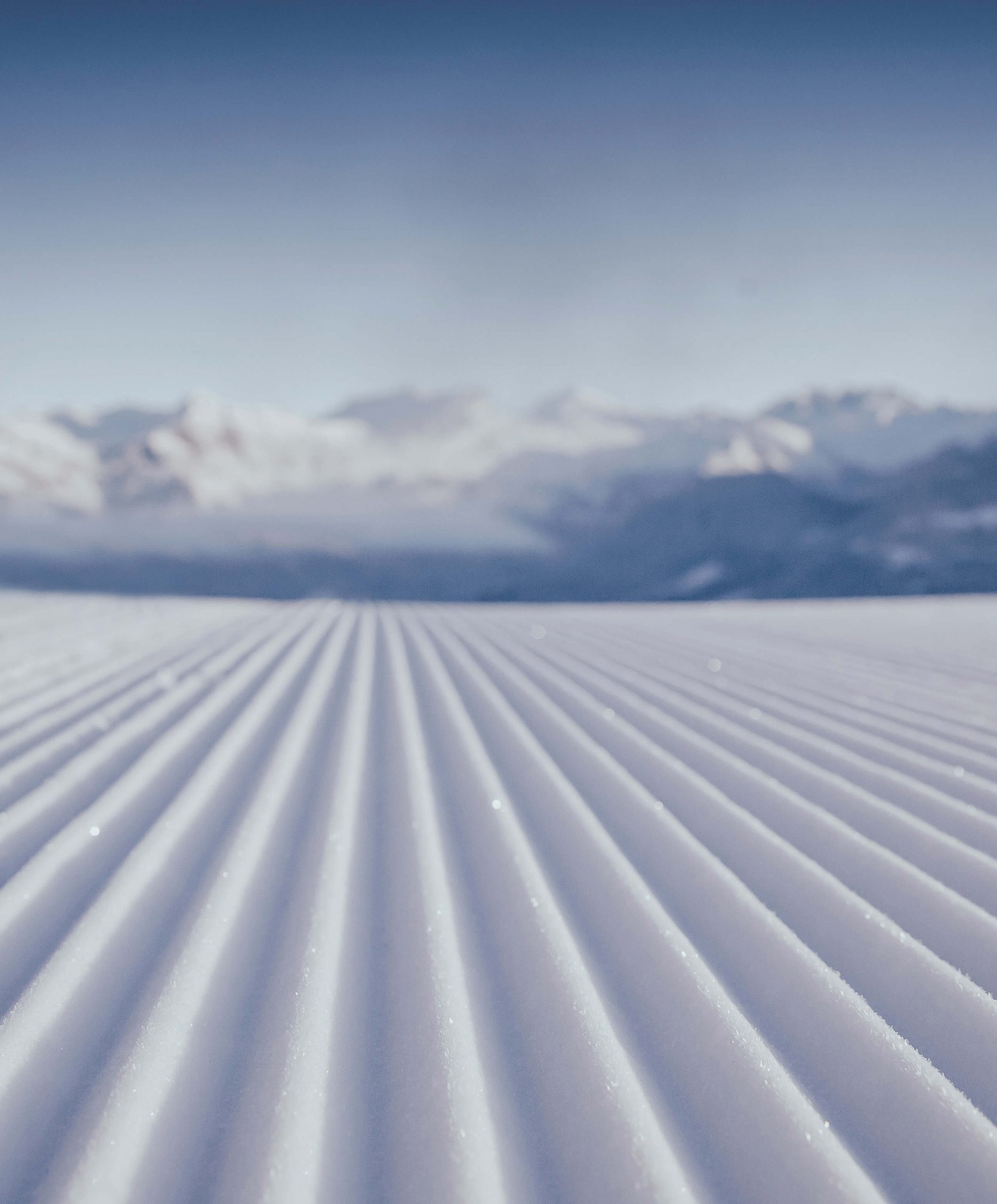
24 Nov Sculpting a Mountain
The sun is starting to set behind Wyoming’s Rendezvous Mountain as the last and most committed skiers descend to the base area after a beautiful bluebird day at Jackson Hole Mountain Resort. As ski patrol sweeps the mountain to ensure no one is lost or in need of help before calling it a day, their grooming colleagues are gearing up in a large slopeside meeting room adjacent to their shop and maintenance facility. While everyone else saddles up to the bar for après-ski festivities or heads home, the grooming team’s first shift is just getting started as they make a plan for how to reset the mountain for the next day.
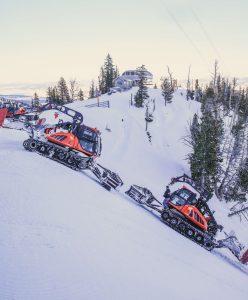
The grooming team practices the rescue of a stuck machine, using the winch to pull them both back up onto the trail.
With over 130 named ski runs spanning 2,500 acres and 4,139 feet of terrain to cover before tomorrow, there is an impressive self-assurance in the team’s ability to get the job done. There is also an inherent, racing-the-clock sense of urgency. While the mountain started the day in great shape, it has been destroyed by the sun, wind, variable temps, and, most impactfully, the sharp edges, side slipping, and overall mayhem brought to the snowpack by skiers and boarders. When you think about hundreds of thousands of tracks being made in the snow — all going downhill and pushing the snow down as they go — it’s amazing that any skiable snow or recognizable features are left on the mountain by the end of the day.
That’s where the grooming team comes in — to repair, reshape, and build the mountain back up. They are sculptors at heart — artists, if you will — applying their craft and skill to an entire mountain to shape it for tomorrow’s adventures. Armed with centuries of combined experience, a deep passion for snow sports, and, most importantly, the equipment to achieve this level of artistry on such a vast alpine tapestry, this team of mountain sculptors takes its job seriously every day of the season. “You have to sculpt your own destiny,” says Dan Williams, one of the more experienced groomers on the team. “We want to build the mountain into the best version of itself, into the mountain we want to ride the next day.”
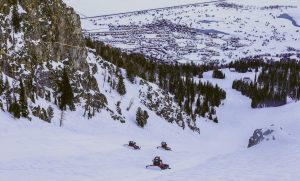
Groomers work in formation in Laramie Bowl to reset the mountain for the next day’s riders.
As they make a plan for the night, they factor in the weather forecast, on- mountain observations from the day, and long-term project goals. On-mountain safety and enjoyment are both at the forefront, a driving force dictating each night’s plan. The grooming team works closely with ski patrol, snow-making, and other operations departments to deliver the best mountain for everyone, especially those who have traveled from far and wide to experience Jackson Hole skiing and snowboarding.
“This is a special group of guys who know they are not signing up for the day shift,” says Tim Mason, vice president of operations. “Groomers get out there and touch their product every day. They take pride in their work, and it shows.” With their unusual schedule of 4:30 p.m. to midnight for the first shift or 11:30 p.m. to 8 a.m. for the second, they do most of their work at night — in the dark and in all conditions. “The mountain changes at night,” says Mason. “Things are different up there in the dark.”
When I visited, the day was clear and the night equally lovely, but it isn’t always so pleasant, and this crew is expected to perform in all weather — no small feat given the reputation for winter weather in northwestern Wyoming. While the average snowfall at the resort is an impressive 458 inches per season, last winter saw a record-setting 595 inches of snowfall at Rendezvous Bowl. It’s hard enough to know where you are on the mountain during the day in a blizzard; think about traversing many of the mountain’s steepest parts in those conditions at night while operating heavy machinery.
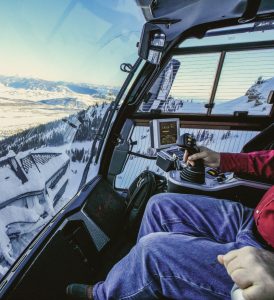
Working on the upper mountain offers incredible views on a clear day, but comes with eye-popping exposure and a need for caution given the steep, craggy nature of Jackson Hole Mountain Resort.
Earl Ward started grooming for Jackson Hole Mountain Resort in 1978. “It gets pretty Western up here when it’s snowing and blowing,” he says in a calm, understated tone. “I’ve been buried a couple [of] times along the track; the whole slope can go at any time.” A barely perceptible smile curves his lips in old-school Wyoming fashion. This guy has seen it all. The mountain is big, and being up there in the dark, in poor visibility, with high wind, and a very steep drop less than a foot from your downhill track is as real as it gets.
Still, even after all these years, Ward is as keen as ever to make the mountain the best version of itself, and it shows. He carefully maneuvers the groomer along the Tensleep Traverse under the famed Corbet’s Couloir. Drifting snow has all but buried the trail that Ward uncovers by making several passes with his plow blades carefully angled into the slope. Once the trail is uncovered and resurfaced, he moves down to where the trail tightens — a rocky road cut on one side and a sheer cliff on the other that leads down into the expert chutes. As the excess snow builds up in front of his blade, he turns the groomer toward the edge, and the snow slides off into the extremely steep Meet Your Maker chute. Even in clear conditions, it’s hard to see where the trail ends and the sky begins — the snow falls away, almost imperceptibly, down into the bowl below.
While most sculptors use chisels, hammers, scrapers, and even their bare hands, this merry band of alpine artists’ tool of choice is a top-of-the-line Prinoth Bison grooming machine, an aptly named piece of equipment for this remote part of the world that was home to the last free-roaming American bison in the wild. The inside of the cockpit is a cross between a tractor, fighter jet, and submarine. The operator’s left hand controls both tracks, which turn independently using two very sensitive shifters. One small movement can get this massive machine to turn 360 degrees instantly.
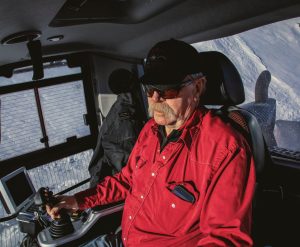
Earl Ward applies decades of experience in the pilot’s seat of his grooming machine.
The operator’s right hand controls the blade, which can move in almost every direction and is equally sensitive. The joystick includes numerous control features that allow the blade to do just about anything a well-trained and experienced groomer wants. While these operators make this look as easy as a teenager playing Call of Duty, it is anything but. The depth, angle, and quality of the snow are always changing, requiring a capable hand combined with an artist’s imagination and a dancer’s coordination.
Finally, the tiller on the back of the machine is pulled over the snow to create the finished, groomed ski run that everyone loves to see in the morning. That perfect corduroy is the groomer’s version of patina, the finish on the surface of their masterpiece. The trick is to get the groomed surface to blend seamlessly after each pass of the machine. Often, this requires several machines working together.
The fleet of groomers includes 10 different machines split evenly between free groomers and winch cat groomers. The five winch cats are equipped with a cable-and-pulley system that attaches to an anchor point on the mountain. The machine is then lowered down the steepest of slopes with stability and safety. The 4.5 tons of pulling force and hinged cable arm allow the machine to move freely; it feels like it’s driving on flat ground despite working up and down steep, icy ski runs.
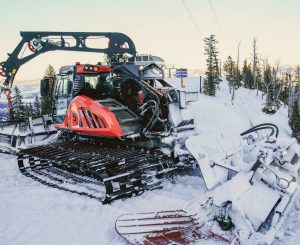
The Prinoth Bison grooming machine is the tool of choice for the sculptors of the mountain.
It’s coming onto the middle of the first shift, and the night is pitch black when groomer Duane Newman hops out of his machine to attach his winch cat cable to an anchor point before lowering himself off into the dark abyss. The feeling of this massive machine dropping off the edge of the trail is not unlike the sensation when your skis first fall over the edge — only it’s slow motion, and you’re sitting in a climate-controlled cabin listening to music and the chatter of the radio drift off as everyone settles into their nightly routines. This route is in especially bad shape, as it is one of the main exit runs off the mountain. “Skiers push the snow downhill all day, and we do our best to push it back up,” says Newman as he begins pushing snow from the bottom of his reach back toward the top. He plans to rebuild the lost base toward the top by making as many laps as it takes to bring the snow back up. Each pass helps pack the snow down using the tracks and the tiller. When he is finished, the run looks as good as new despite no new snow falling overnight. Back at the top, he disconnects his cable and moves on to the next project, the mountain slowly taking shape as the night passes.
The knowledge, experience, passion, and desire of the grooming team are impressive. It takes years of mentorship, practice, and on-the-job training to gain an even basic level of proficiency at such a complex and demanding job. The camaraderie from such intense work is palpable — there’s a lot of laughter, smiles, and an unspoken shared commitment to excellence. When they get out there and touch their creation, it is from the vantage point of an artist.




Barbara Panfile
Posted at 13:24h, 17 DecemberInsightful article about the important grooming of the slopes and the persons involved.